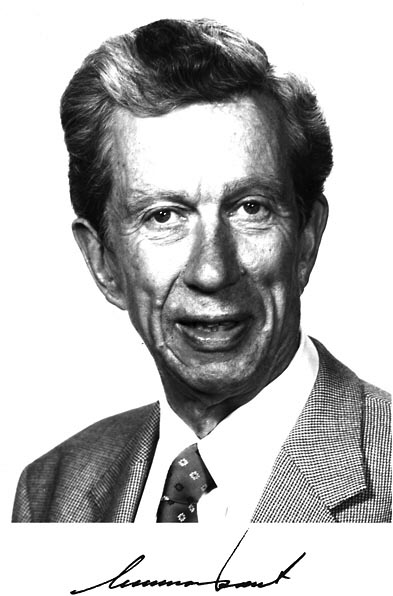GUNNAR FANT
1919–2009
Elected in 1982
“For pioneering development of acoustic theory of speech production and innovative leadership in communications technology and in development of prosthetic devices.”
BY JAMES L. FLANAGAN, HANS G. FORSBERG AND WILLIAM W. LANG
GUNNAR FANT, a pioneer in research on human speech, died on June 6, 2009. Gunnar was internationally respected for his contributions to an understanding of how the sounds of speech are shaped by the human vocal tract and for his fundamental contributions to the fields of speech communication and human language analysis. His work during the latter half of the 20th century set research patterns and techniques for a generation of students and researchers of speech science.
Gunnar was born in Nyköping, Sweden, on October 8, 1919. His studies and degrees, indeed almost all of his technical career, were spent at the Royal Institute of Technology (KTH) in Stockholm. He received his master’s degree in electrical engineering in 1945, with a thesis on how the understanding of speech depends on interference and telephonic limitations in its transmission. For a short time he was employed in the telephone research laboratory of the Ericsson Group, where he carried out acoustical analyses of the sounds of Swedish speech and worked on problems related to the transfer of speech through telephone cables.
In 1949, at the invitation of Leo Beranek, whom he met on Leo’s visit to the Ericsson laboratory, Gunnar came to the Massachusetts Institute of Technology (MIT) and Harvard as a
visiting scholar. His interactions with linguists beginning with Roman Jakobson and Morris Halle introduced a quantitative engineering component to the study of language. Their collaboration led to the publication of an MIT report in 1952, after Gunnar had returned to Sweden. Titled “Preliminaries to Speech Analysis—The Distinctive Features and Their Correlates,” the vision and grasp of the report engage linguists to the present day. He also initiated a career-long interaction with the speech group at MIT under Ken Stevens. He applied his knowledge of signal processing and acoustics to the study of human production and the perception of speech sounds and to a potential universal organization of basic phonological units.
Returning to Sweden in 1951, Gunnar established the Speech Transmission Laboratory at KTH. It quickly became a world center for speech research and related technical developments—all aspects of speech processing, including analysis, synthesis, recognition, production, and perception. The STL was also involved with prosthetic engineering that included speech training devices for the deaf and reading machines for the blind.
By 1958 Gunnar had assembled his research into a monumental doctoral dissertation which included a book, The Acoustic Theory of Speech Production (Mouton, 1960), and a monograph, Acoustic Analysis of Speech with Applications to Swedish (Ericsson Technics, 1959). His theory describes in general what speech is physically and explains how vowels and consonants are formed to produce distinctive acoustical characteristics. This was a pioneering quantitative advance on how speech sounds are generated and filtered by the dynamically changing vocal tract. These publications, especially his book, quickly became standard references in the field of speech processing. Gunnar’s theory underlies much of the current technology of voice communication by analysis-synthesis methods. His description of speech is general—independent of language, valid for both normal and distorted speech, and covering the human voice both singing and speaking. He used this theory to design a series of speech
synthesizers; a commercial version (OVE III) enjoyed wide use because of the quality of both its speech and its engineering. He also developed an improved vocoder that Ericsson built for military use.
Over a period of more than four decades, Gunnar attracted and worked with many colleagues and students on a variety of topics related to speech technology, speech disorders and acquisition, and other aspects of speech and language. His mode of interaction was informal, with coffee breaks and friendly discussion on many topics. Each year his laboratory produced progress reports that were referenced by researchers around the world.
In 1961 Gunnar received the Gold Medal of the Royal Swedish Academy of Engineering Sciences (IVA). He was elected a member of IVA in 1963—one the youngest members—and became professor at KTH in 1966. He was elected a foreign associate of the National Academy of Engineering in 1982. Gunnar retired formally in 1987 but remained a leading scientist at KTH until his death in 2009.
Gunnar received many other honors during his over 50 years in the field. In 1980 he received the Silver Medal of the Acoustical Society of America. In 1985 he was jointly named with Jim Flanagan to share the L. M. Ericsson International Prize in Telecommunications. In 2004 Gunnar received jointly with Ken Stevens the Institute of Electrical and Electronics Engineers (IEEE) Signal Processing Society’s James L. Flanagan Speech and Audio Processing Award.
Gunnar created a unique fellowship within his laboratory and with colleagues worldwide that was characterized by friendship, caring, respect, scientific freedom, and collaboration. For all of us who knew him and worked with him, he leaves deep loss, but with many fond memories, both technical and social. He is survived by his daughter, Maria Fant Laitanen, and his son, Anders Fant.





